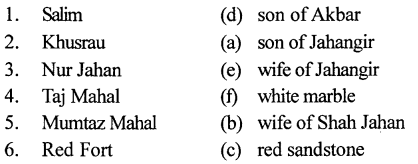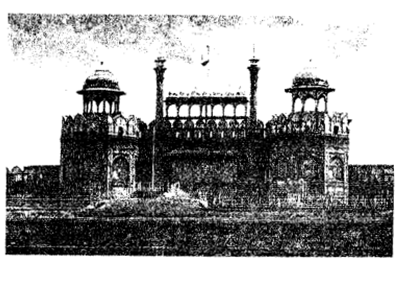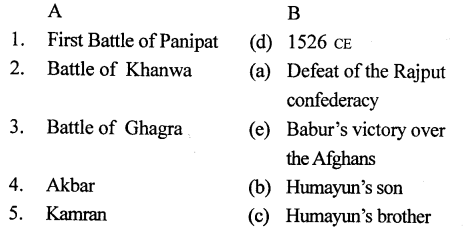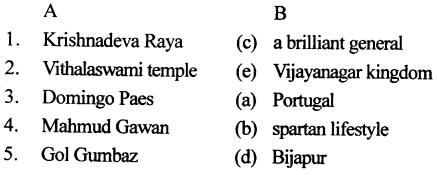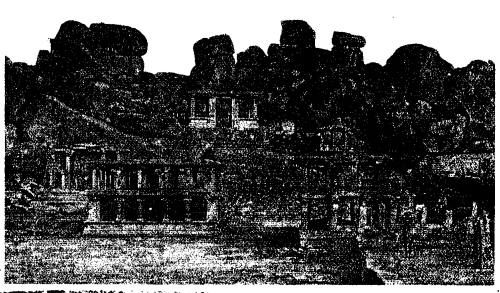The Trail History and Civics for Class 7 ICSE Solutions – Bhakti and Sufi Movements
ICSE SolutionsSelina ICSE SolutionsML Aggarwal Solutions
Trail HistoryCivics Focus on HistoryCivicsGeographyMathsPhysicsChemistryBiology
EXERCISE
A. Fill in the blanks :
- As the spirit of tolerance and understanding developed between the Hindus and the Muslims, two liberal religious , reform movements took shape in the Medieval Period. They were the sufi and Bhakti movements.
- The Sufis came to India with the Turks in the 12th century CE. Over the years, they absorbed Buddhist and Hindu influences and were greatly respected by the Muslims as well as the Hindu.
- The Bhakti Movement began in South India in the 7th century CE and became a popular movement before the arrival of the Turks.
- There were 10 Sikh gurus.
- The holy book of the Sikhs is known as the Shri Guru Granth Sahib ji.
- The Sikhs worship in a Gurdwara which means door of the Guru.
B. Match the following :

Answer:
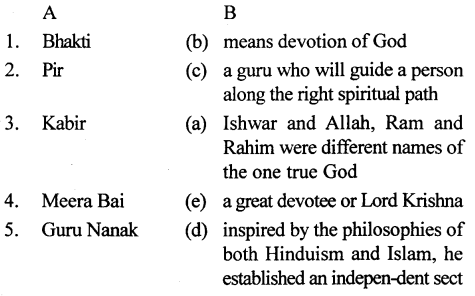
C. Choose the correct answer :
1. The Sufis were a group of Hindu/Buddhist/Muslim mystics.
Ans. The Sufis were a group of Muslim mystics.
2. The word ‘bhakti’ means fear of God/following rituals/ devotion to God.
Ans. The word ‘bhakti’ means devotion to God.
3. The Bhakti saints drew their inspiration from the Bhagwad Gita and the Vedas/Puranas/Upanishads.
Ans. The Bhakti saints drew their inspiration from the Bhagwad Gita and the Upanishads.
4. Guru Nanak/Guru Tegh Bahadur/Guru Gobind Singh was the founder of the Sikh religion.
Ans. Guru Nanak was the founder of the Sikh religion.
5. The word ‘Sikh’ is derived from a word which means teacher/disciple/warrior.
Ans. The word ‘ Sikh’ is derived from a word which means disciple.
D. State whether the following are true or false :
1. The organization of the Sufis was known as the sangha.
Ans. False.
Correct : The organization of the Sufis was known as the silsilas.
2. Bhakti saints believed in monotheism.
Ans. True.
3. Ramananda taught his message through dohas.
Ans. False.
Correct : Kabir taught his message through dohas.
4. Chaitanya Mahaprabhu was a believer in the importance of following rituals.
Ans. False.
Correct : Chaitanya Mahaprabhu was a believer in the existence of God.
5. Guru Tegh Bahadur was executed by Aurangzeb.
Ans. True.
E. Answer the following questions in one or two words/ sentences :
Question 1.
Who were the Sufis?
Answer:
The Sufis were a group of Muslim mystics who started a religious reform movement in West Asia.
Question 2.
What are silsilas?
Answer:
Silsilas were the monsastic organizations of the Buddhist sangha and the Sufis.
Question 3.
Name the two popular Sufi orders in India.
Answer:
Chishti and the Suhrawardi orders, became popular in India.
Question 4.
What is the importance of qawwali in Sufism?
Answer:
One could come closer to God through devotional music qawwali.
Question 5.
Mention any one positive effect of the Bhakti Movement on Hindu-Muslim unity.
Answer:
People were attracted to the principles of monotheism, equality and ritual-free worship. By propagating its principles of one God, universal brotherhood and respect for all religions, the Bhakti Movement created conditions conducive to the harmonious and peaceful coexistence of Hindus and Muslims.
Question 6.
What are dohas?
Answer:
Dohas were the simple, beautiful Hindi verses (poems) through which Kabir spread his message.
Question 7.
How did Meera Bai spread the message of Bhakti among the people.
Answer:
Meera Bai spread the message of devotion and love for God through devotional songs called Meera’s bhajans.
Question 8.
Name the five sacred symbols of Sikhism.
Answer:
The five sacred symbols of Sikhism are :
(a) Kesh
(b) Kanga
(c) Kaccha
(d) Kirpan
(e) Kara
Question 9.
Who transformed the Sikhs into a martial race?
Answer:
Guru Gobind Singh transformed the peace-loving Sikhs into a martial race.
Question 10.
How did the Sufi and Bhakti movements lead to the development of local languages?
Answer:
The Bhakti and Sufi saints preached in the language of the common people and this led to the development of local language.
F. Answer the following questions briefly :
Question 1.
What are the important teachings of the Sufi saints? Explain the impact of Sufism on the people and their rulers?
Answer:
Teachings of Sufism :
(a) There is only one god and all people are his children.
(b) All human beings are equal.
(c) Different religions are different paths leading to one God. Therefore, all religions must be respected.
(d) It is necessary to follow the path shown by a pir, who will guide a person along the right spiritual path.
The liberal ideas and rational principles of sufism, had great impact on the people and their rulers. It encouraged religious tolerance promoted the idea of universal brotherhood and brought the Hindus and Muslims closer to one another.
Question 2.
Explain the origin of the Bhakti Movement in India. Why did the teaching of the Bhakti saints appeal to the people?
Answer:
The word ‘bhakti’ means devotion to God. The Bhakti Movement was a reform movement within Hinduism. It began in South India in the 7th century CE and became a popular movement before the arrival of the Turks. The Bhakti saints drew their inspiration from the Upanishads and the Bhagavad Gita. People were attracted to the principles of monotheism, equality and ritual-free worship. By propagating its principles of one God, universal brotherhood and respect for all religions, the Bhakti Movement created conditions conducive to the harmonious and peaceful coexistence of Hindus and Muslims.
Teachings of the Bhakti saints :
(a) There is only one God. Everyone is equal in the eyes of God.
(b) God can be reached through love and devotion and total surrender to his will and not through rites rituals and idol worship.
(c) Everyone should lead a pure life.
Question 3.
Mention the chief teachings of the Bhakti saints.
Answer:
Teachings of the Bhakti saints:
(a) There is only one God. Everyone is equal in the eyes of God.
(b) God can be reached through love and devotion and total surrender to his will and not through rites rituals and idol worship.
(c) Everyone should lead a pure life.
Question 4.
Mention the important teachings of Sant Kabir.
Answer:
Sant Kabir stressed the idea of one God. He taught that Ishwar, Allah, Ram and Rahim were different names of one God. He spread the message of Hindu-Muslim unity, Universal brotherhood, tolerance and banned idol worship, caste system and rituals. Kabir preached his message through simple beautiful Hindi poems called Dohas.
Question 5.
What are the main teachings of Guru Nanak? Why is the holy book of the Sikhs known as the Guru Granth Sab ib?
Answer:
The important teachings of Guru Nanak are as follows :
(a) There is only one God and He is the creator of this universe.
(b) All human beings are equal. The caste system must be rejected and the principle of universal brotherhood must be followed.
(c) Everyone should lead a good and pure life based on truth and kindness, and discard idol worship and ritualism.
(d) True spiritual knowledge can be gained under the guidance of a guru.
The last Guru Gobind Singh Ji, transferred the authority of the Guru to the holy scriptures called the ‘Adi Granth’ which came to be known as the Guru Granth Sahib. The teachings of all the Gurus are contained in it and it serves as a guide or Guru.
Question 6.
What effect did the Bhakti and Sufi movements have on Indian society?
Answer:
The Bhakti and Sufi movements brought a new era in Indian society which was based on tolerance and brotherhood among the human beings. Following are the impact of the movements :
(a) The Bhakti and Sufi movement preached in the language of the common man which gave rise to development of common languages.
(b) The common man came to know about great truths of Hindu philosophy which helped in slowing down conversions during this period.
(c) These movements helped in reducing the superiority of the brahmanas.
(d) They also brought feeling of universal brotherhood and created an environment of tolerance and mutual respect.
G Picture study :
This is the picture of a monument associated with the founder of a religious reform movement in India. (Picture on next page)
Question 1.
Name the reformer and the movement he started in India.
Answer:
Religious reformer was Moinuddin Chishti. He started Sufi- Movements.
Question 2.
Identify the monument.
Answer:
Dargah of Moinuddin Chisti.

Question 3.
Why is this monument famous?
Answer:
This monument is famous for its teachings
(a) All human beings are equal and God is only one.
(b) All religions must be respected.
(c) Fasts and other rituals are not necessary.
(d) There is no need to convert to another religion.
Question 4.
Mention any four important religious principles of that movement, which are common to the principles of the Bhakti Movement.
Answer:
(a) There is only one God.
(b) Everyone is equal in the eyes of God.
(c) God can be reached through love and devotion and total surrender to His will and not through rites, rituals and idol worship.
(d) Eveyone should lead a pure life.
Question 5.
Name any two religious reformers of the Bhakti Movement.
Answer:
Ramananda, Guru Nanak Dev ji.
OTHER IMPORTANT QUESTIONS
Question 1.
Why was the Bhakti movement revived and strengthened in the Medieval Period?
Answer:
The Bhakti movement revived and strengthened during the Medieval Period as people got attracted to the principles of equality, one God, universal brotherhood and respect for all religions. This movements provided conducive conditions for peaceful and harmonious co-existence of the Hindus and Muslims.
Question 2.
What are the main principles of Sikhism?
Answer:
The main principles of Sikhism are :
(a) There is only one God and he is the creator of this universe.
(b) All human beings are equal. The caste system must be rejected and the principles of universal brotherhood must be followed.
(c) Everyone should lead a good and pure life based on truth and kindness, and discard idol worship-and ritualism.
(d) True spiritual knowledge can be gained under the guidance of a guru.
Question 3.
Why is the Sikh religion also referred to as Gurumat?
Answer:
In Sikh religion Guru acquires the central position. The word sikhis derived from a word which means disciple, so Sikhism is also referred to as Gurumat means guru’s doctrine.
Question 4.
What provoked Guru Govind Singh to infuse his followers with the martial spirit?
Answer:
To save the people from cruelty of Mughal rulers, Guru Govind Singh infused his followers with the martial spirit.
Question 5.
Throw some light on how the Sufis came to India?
Answer:
The Sufis came to India with the Turks in the 12th century. As the course of time went on, they absorbed Buddhist and Hindu influences and were greatly respected by the Muslims as well as the Hindus.
Question 6.
Who was the founder of the Sufi movement in India?
Answer:
The founder of the Sufi movement in India was Moinuddin Chisti. His dargah in Ajmer is an important pilgrimage centre for both the Muslims and the Hindus.


